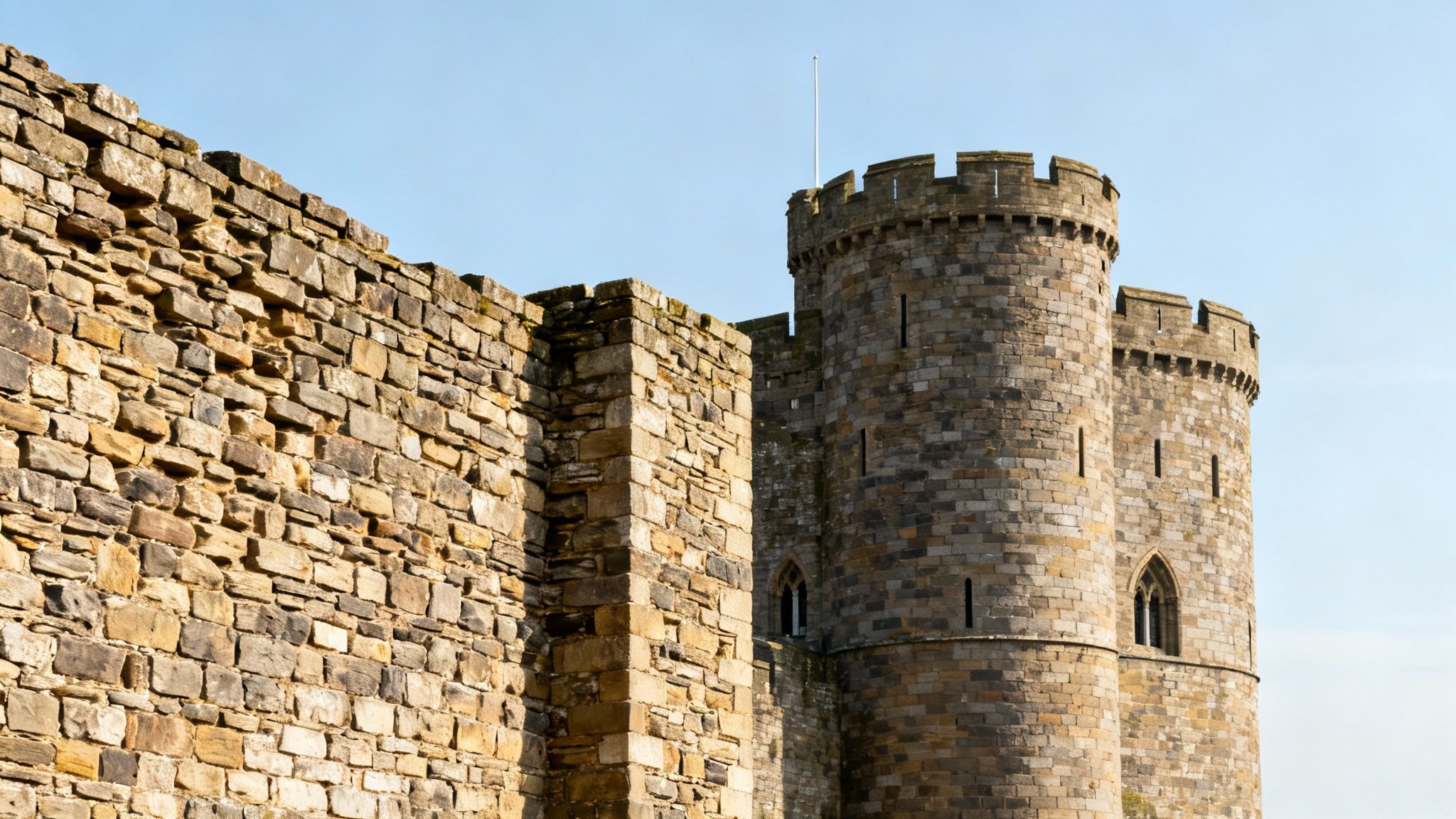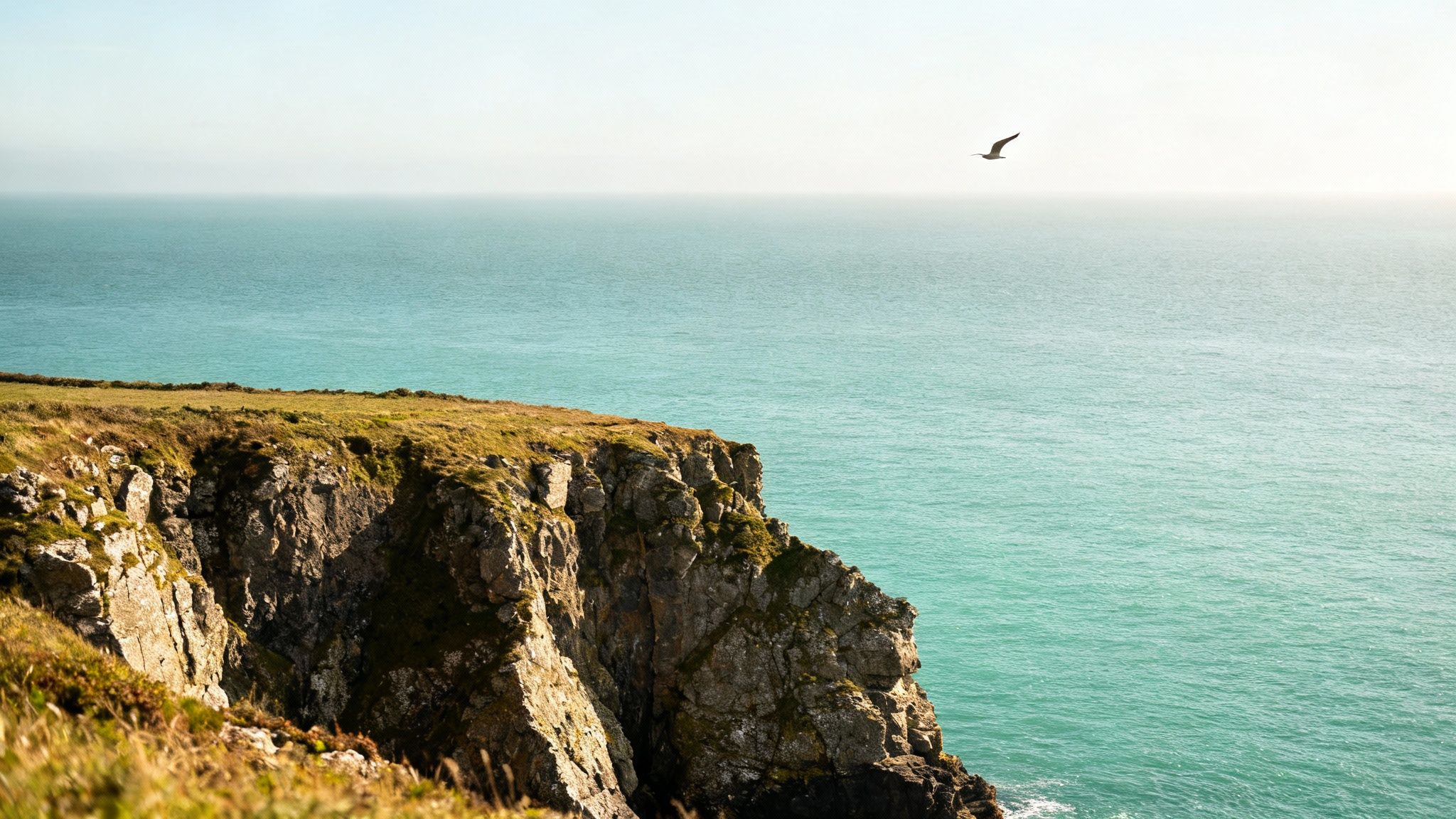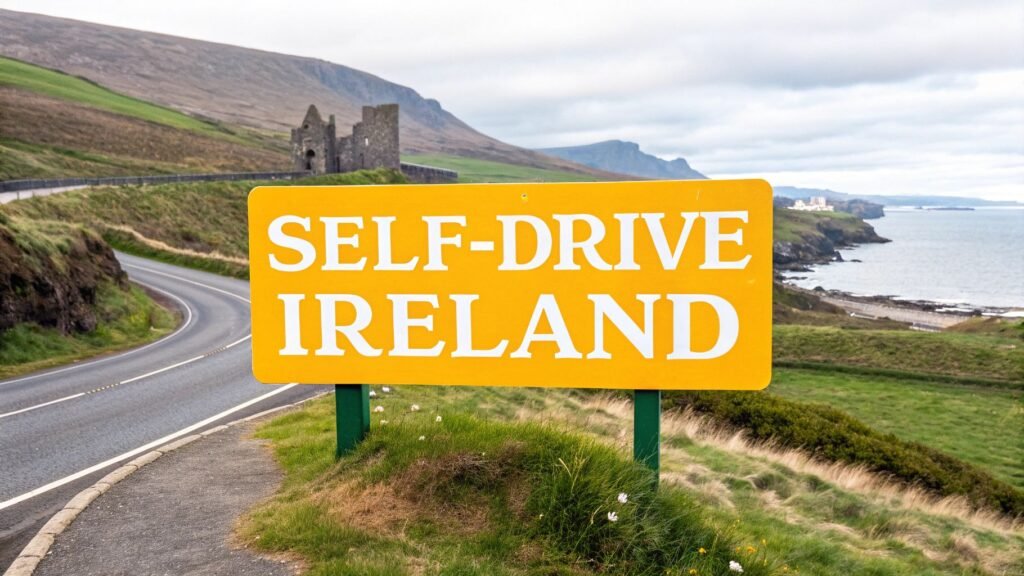Welcome to Wales, a land where ancient myths breathe life into dramatic landscapes and every winding road reveals a new story. From the soaring peaks of Snowdonia to the historic heart of Cardiff, discovering what to see in Wales is an adventure in itself. This guide is crafted specifically for the independent traveller, the one who craves the freedom of the open road and the joy of uncovering hidden gems at their own pace. Forget generic itineraries; we are providing a detailed roadmap to the soul of this captivating country.
This comprehensive listicle moves beyond simple descriptions. We will navigate you through 10 of Wales' most unmissable destinations, from UNESCO World Heritage castles to pristine national parks and charming coastal villages. Each entry is packed with practical, actionable advice tailored for a self-drive journey, ensuring you can make the most of every stop. You'll find specific tips on parking, ideal visiting times to avoid crowds, and suggestions for nearby attractions that are often overlooked.
Whether you're planning a grand tour or seeking inspiration for your next weekend escape, prepare to explore the fortresses, coastlines, and vibrant culture that make Wales a truly unique destination. We have organised this roundup to help history enthusiasts, nature lovers, and cultural explorers alike build a flexible and deeply personal Welsh adventure. This isn't just a list; it is your blueprint for an unforgettable exploration of a country rich with beauty and heritage. Let's begin the journey.
1. Snowdonia National Park (Eryri)
Dominating the landscape of North Wales, Snowdonia National Park, or Eryri, is a breathtaking expanse of raw, natural beauty. Covering 823 square miles, it is Wales’ largest national park and a must-see for any traveller. Its centrepiece is Yr Wyddfa (Mount Snowdon), the highest peak in Wales and England, which draws adventurers to its summit for panoramic views that stretch for miles on a clear day.

But Eryri is far more than just one mountain. The park’s diverse terrain encompasses everything from rugged, glacier-carved valleys and ancient woodlands to serene lakes and a stunning coastline. This variety makes it a perfect destination for self-drive travellers, offering a new dramatic vista around every bend in the road.
Practical Tips for Your Visit
To make the most of your trip, planning is essential. The weather here is notoriously changeable, so preparation is key to a safe and enjoyable experience. For a deeper dive into organising your journey, explore our comprehensive guide to Snowdonia National Park (Eryri).
- Plan Your Hike: For a quieter ascent of Yr Wyddfa, consider less-trodden routes like the Rhyd Ddu Path or Watkin Path. Always check the weather forecast before setting off and be prepared for all conditions with layers, waterproofs, and sturdy hiking boots.
- Book in Advance: If hiking isn’t your preference, the historic Snowdon Mountain Railway offers a spectacular journey to the summit. Tickets sell out quickly, especially during peak season, so booking well in advance is crucial.
- Beat the Crowds: Car parks, particularly at popular trailheads like Pen-y-Pass, fill up extremely early. Aim for a pre-dawn start to secure a space and enjoy the tranquillity of the mountains before the crowds arrive.
- Stay Connected: Mobile phone signal is often unreliable in the park's remote areas. Download offline maps and route information to your device before you travel to ensure you can navigate safely.
2. Cardiff Castle
Standing proudly in the heart of Wales's capital, Cardiff Castle is a remarkable site encapsulating over 2,000 years of history. Its layers tell a story that begins with a Roman fort, continues with a formidable Norman keep, and culminates in a spectacular Victorian Gothic revival masterpiece. This unique blend of architectural styles makes it one of the most intriguing and popular heritage sites in the country.

The castle owes its most famous features to the collaboration between the fantastically wealthy 3rd Marquess of Bute and the eccentric architect William Burges. Together, they transformed the castle into a fairy-tale vision, creating lavishly decorated apartments filled with ornate carvings, dazzling stained glass, and intricate murals. Exploring these rooms feels like stepping into a medieval fantasy, making it an unmissable stop on any Welsh itinerary.
Practical Tips for Your Visit
To truly appreciate the castle's rich detail, it's wise to plan your visit. From accessing hidden rooms to avoiding the busiest times, a little foresight goes a long way. For more inspiration on urban adventures in the UK, see our guide to unforgettable city breaks.
- Book Your Tour: While a general admission ticket grants access to the grounds and keep, the most breathtaking Victorian apartments can only be seen on a guided house tour. Book this online in advance to secure your spot.
- Time Your Arrival: The castle is a popular destination for tour groups. Arrive early in the morning right at opening time, or later in the afternoon, to enjoy a more relaxed experience with fewer crowds.
- Don't Miss the Tunnels: Explore the castle's walls to discover the wartime shelters. These atmospheric tunnels were used as air-raid shelters during the Second World War and offer a fascinating glimpse into a different chapter of Cardiff's history.
- Check the Calendar: Cardiff Castle frequently hosts special events, from medieval banquets and jousting tournaments to open-air concerts. Check their official website before your visit to see if your trip coincides with a unique event.
3. Pembrokeshire Coast National Park
As Britain’s only truly coastal national park, Pembrokeshire offers a staggering 186 miles of some of the most spectacular coastline in the world. Located in Southwest Wales, this park is a haven for those wondering what to see in Wales beyond the mountains. It’s a mesmerising blend of rugged cliffs, golden sandy coves, ancient castles, and charming seaside towns, all connected by the world-renowned Pembrokeshire Coast Path.

The park’s dramatic landscape is not just a feast for the eyes; it is also a vital sanctuary for wildlife. The offshore islands, such as Skomer, are internationally important breeding grounds for seabirds, including thousands of puffins. The crystal-clear waters are home to grey seals, dolphins, and porpoises, making it an exceptional destination for nature lovers and self-drive travellers exploring the region's diverse scenery.
Practical Tips for Your Visit
Proper planning will help you fully appreciate the coastal wonders of Pembrokeshire. From wildlife watching to adventure sports, the park offers a wealth of activities. For more ideas on how to incorporate this stunning coast into your journey, explore our detailed itinerary on this tour through South England and Wales.
- Walk a Section of the Path: While walking the entire 186-mile Coast Path is a major undertaking, you can easily enjoy shorter sections. The walk from Stackpole to Barafundle Bay is a popular choice, rewarding you with one of Britain’s best beaches.
- See the Puffins: To see the famous puffin colonies on Skomer Island, you must book a boat trip. The season runs from April to July, and tickets sell out months in advance, so early booking is essential.
- Try Coasteering: Pembrokeshire is the birthplace of coasteering, an exhilarating mix of climbing, scrambling, and swimming along the rocky shoreline. Book with a reputable local provider for a safe and unforgettable adventure.
- Check the Tides: Many of the park's most beautiful coves and sea caves are only accessible at low tide. Always check tide times before setting out to explore coastal features or secluded beaches.
4. Conwy Castle and Town Walls
A masterpiece of medieval military architecture, Conwy Castle stands as a formidable testament to the power of King Edward I. Built between 1283 and 1289 by the celebrated architect Master James of St. George, this UNESCO World Heritage Site is a key part of the ‘Iron Ring’ of fortresses designed to secure English dominance over Wales. Its eight imposing towers and high curtain walls create a brooding, powerful silhouette against the Conwy estuary and the distant mountains of Snowdonia.

What makes Conwy exceptional is the remarkably complete set of medieval town walls that encircle the historic town. Stretching for three-quarters of a mile and punctuated by 21 towers, these walls offer an immersive journey back in time. Walking their circuit provides not just a defensive perspective of the castle, but also stunning, elevated views of the town, the harbour, and the dramatic Welsh landscape beyond, making it an unmissable part of what to see in Wales.
Practical Tips for Your Visit
To truly appreciate Conwy, plan to spend at least half a day exploring both the castle and the surrounding town. The combination of fortress, walls, and historic streets offers a uniquely preserved medieval experience.
- Walk the Walls: The full circuit of the town walls is free to access and takes around 45 minutes to an hour. It provides the best photo opportunities of the castle and the estuary. Start your walk near the railway station for a great initial approach.
- Arrive Early or Late: To capture the castle without the crowds and in the best light, aim for an early morning visit. Alternatively, the late afternoon sun casts a beautiful golden glow on the stone, perfect for photography.
- Climb Every Tower: Each of the castle’s main towers offers a different vantage point. Climbing them is essential to fully grasp the strategic layout of the fortress and to enjoy the panoramic views that change with every new perspective.
- Explore the Town: Don't miss the historic treasures within the walls, including Plas Mawr, a beautifully preserved Elizabethan townhouse, and the aformentioned Smallest House in Great Britain, located on the quayside.
5. Brecon Beacons National Park
Stretching across 520 square miles of South Wales, the Brecon Beacons National Park offers a landscape of immense variety and understated beauty. It is a region defined by its rolling green uplands, dramatic escarpments, and the iconic flat-topped peaks that give the park its name. The highest of these, Pen y Fan, stands at 886 metres and provides a rewarding challenge for walkers seeking panoramic views over the Welsh countryside.
Beyond the central peaks, the park's character shifts to reveal secluded waterfalls, vast cave networks, and tranquil reservoirs. This diverse terrain makes it an exceptional destination for those exploring by car, with scenic drives connecting historic market towns like Hay-on-Wye, the world-famous "town of books", and dramatically situated fortresses such as Carreg Cennen Castle. The park is also an International Dark Sky Reserve, offering some of the best stargazing opportunities in Europe.
Practical Tips for Your Visit
To fully appreciate the Brecon Beacons, a little forward planning goes a long way, especially when venturing into the mountains or exploring its more remote corners. For ideas on how to weave this stunning region into a larger journey, discover our range of self-drive tours in Wales.
- Choose Your Route: To climb Pen y Fan while avoiding the busiest paths, consider the quieter, more scenic Cwm Llwch route. As with any mountain walk, always check the weather forecast and carry appropriate gear.
- Discover Waterfall Country: The area around Ystradfellte is home to the spectacular Four Waterfalls Walk. Be sure to wear sturdy, waterproof footwear as the paths can be slippery, and a waterproof jacket is a good idea to protect from the spray.
- Plan for the Dark: To make the most of the park's Dark Sky status, check the schedules for stargazing events often held at visitor centres. For the best experience, aim for a clear night with a new moon.
- Book Activities in Advance: Popular attractions like the show caves at Dan yr Ogof can get very busy. Booking your tour tickets online ahead of time is highly recommended, particularly during school holidays.
- Explore Beyond the Peaks: Consider renting an electric bike to explore the gentle, scenic towpaths of the Monmouthshire and Brecon Canal, offering a different perspective on the park's beauty.
6. Portmeirion Village
Nestled on a private peninsula in North Wales, Portmeirion is an enchanting Italian Riviera-inspired village that feels like stepping into another world. Created by the visionary architect Sir Clough Williams-Ellis between 1925 and 1975, it was designed to show how a naturally beautiful site could be developed without spoiling it. This whimsical collection of colourful, Mediterranean-style buildings, exotic gardens, and coastal views over the Dwyryd estuary is a true architectural marvel.
Portmeirion gained international fame as the iconic setting for the 1960s cult TV series The Prisoner, and its surreal charm continues to captivate visitors. For self-drive travellers exploring what to see in Wales, its unique atmosphere offers a stark, delightful contrast to the rugged mountains and ancient castles found elsewhere in the region. It’s a place designed purely for delight and aesthetic pleasure.
Practical Tips for Your Visit
To truly immerse yourself in this fantasy village, a little planning can enhance the magic. The village is a popular spot, so timing your visit can make a significant difference. For more details on tickets and opening times, visit the official Portmeirion Village website.
- Book Online for Discounts: Purchase your day tickets online in advance to receive a small discount compared to buying them at the gate upon arrival.
- Visit Off-Peak: To experience the village at its most tranquil, aim to visit on a weekday morning. The site becomes much busier in the afternoons and on weekends, especially during school holidays.
- Allow Ample Time: Give yourself a minimum of three hours to wander through the Central Piazza, explore the sub-tropical Gwyllt woodland, and stroll along the estuary.
- Consider an Overnight Stay: For the ultimate experience, stay overnight in one of the village's hotel rooms or self-catering cottages. This allows you to enjoy the magical atmosphere after the day-trippers have departed.
- Capture the Best Light: Photographers will find the soft light of the early morning or late afternoon ideal for capturing the village's vibrant colours and unique architectural details.
7. Caernarfon Castle
A masterpiece of medieval military architecture, Caernarfon Castle is a brute of a fortress, designed as much for intimidation as for defence. This UNESCO World Heritage site was the most ambitious of Edward I’s iron ring of castles, built to assert English dominance over the Welsh. Its imposing, polygonal towers and sheer scale were intended to echo the walls of Constantinople, reflecting Edward’s imperial aspirations.
More than just a military stronghold, Caernarfon was built as a royal palace and the administrative centre of North Wales. Its historical significance was reaffirmed in modern times with the 1969 investiture of Prince Charles as the Prince of Wales, a ceremony held within its ancient walls. Its commanding presence on the banks of the River Seiont makes it a truly unforgettable sight and a key stop on any Welsh itinerary.
Practical Tips for Your Visit
To get the most out of your visit to this historic fortress, a little forward planning goes a long way. The castle is vast, with many towers and passages to explore. For further details on opening times and special events, visit the official Caernarfon Castle website.
- Climb for the Views: Make the ascent of the Eagle Tower your priority. The climb is rewarded with unparalleled panoramic views over the castle complex, the historic town, the Menai Strait, and the island of Anglesey beyond.
- Time Your Visit: The castle is a popular stop for large coach tours. To avoid the biggest crowds, aim to visit on a weekday morning, ideally soon after it opens, allowing you to explore the grounds in relative peace.
- Explore Beyond the Walls: Your ticket often includes access to the town walls. Take the opportunity to walk a section for a different perspective of the castle and the charming harbour area.
- Allow Ample Time: Don’t underestimate the size of the site. To explore the towers, wall walks, and the on-site Royal Welch Fusiliers Museum thoroughly, you should allow a minimum of two to three hours.
8. Llandudno and Great Orme
Known as the 'Queen of Welsh Resorts', Llandudno offers a timeless seaside experience, elegantly blending Victorian architecture with stunning natural beauty. The town is perfectly situated between two sandy shores, with a magnificent Grade II listed pier and a sweeping promenade that has welcomed visitors for over a century. This classic charm makes it a standout on any list of what to see in Wales.
Towering over the town is the Great Orme, a massive limestone headland that offers breathtaking coastal views and a wealth of attractions. From its ancient copper mines, which date back 4,000 years, to the herds of wild Kashmiri goats that roam its slopes, the Orme is a destination in itself. Easily accessible by a historic tramway or a modern cable car, it provides a dramatic natural counterpoint to the refined town below.
Practical Tips for Your Visit
Llandudno’s dual appeal as both a classic resort and a nature haven means a little planning can help you experience both sides of its character. For detailed information on attractions and opening times, check the official Visit Llandudno website.
- Vary Your Ascent: For the best experience of the Great Orme, take the historic Great Orme Tramway on the way up and enjoy the panoramic views from Britain's longest cable car ride on the way down. Book tickets in advance during peak season to avoid queues.
- Walk the Marine Drive: This scenic 3.5-mile toll road circumnavigates the base of the headland, offering spectacular sea views. It’s perfect for a leisurely drive or a bracing walk, providing a different perspective of the coastline.
- Explore Both Shores: While the North Shore bustles with activity around the pier, the West Shore offers a much quieter, more serene beach experience with beautiful views towards Anglesey. It’s the perfect spot for a peaceful sunset walk.
- Embrace the Victorian Vibe: Enhance your visit by staying in one of the many grand Victorian or Edwardian hotels lining the promenade. A stroll along the pier at sunset, followed by traditional fish and chips, is an essential Llandudno experience.
9. St Davids Cathedral and Bishop's Palace
Tucked away in a secluded valley on the Pembrokeshire coast lies Britain’s smallest city, home to one of its greatest spiritual treasures. St Davids Cathedral, founded by Wales’ patron saint in the 6th century, is a breathtaking architectural marvel. The current magnificent structure, dating from 1181, is built from distinctive purple sandstone and features a dramatic sloping floor and an intricately carved oak ceiling.
Adjacent to the cathedral stand the magnificent ruins of the Bishop's Palace, a testament to the wealth and power of medieval church leaders. Despite its remote location, St Davids was a major pilgrimage destination in the Middle Ages, with two journeys here considered equal to one to Rome. This rich history and stunning coastal setting make it an essential stop on any Welsh itinerary, offering a profound sense of peace and heritage.
Practical Tips for Your Visit
To truly appreciate the unique atmosphere of St Davids, it’s worth planning your visit around its spiritual and natural highlights. Allow at least two hours to explore both the cathedral and the palace ruins, with extra time for the surrounding area.
- Make a Grand Entrance: For the most dramatic first glimpse of the cathedral, approach through the 13th-century Porth-y-Twr, the last surviving gatehouse of the original walled close. The view from the top of the steps is unforgettable.
- Experience the Music: If your schedule allows, attend a choral Evensong service. Hearing the choir's voices fill the ancient nave is an exceptionally moving and atmospheric experience. Check the cathedral’s website for service times.
- Explore the City Centre: Wander through the tiny city itself, which is clustered with independent galleries, artisan shops, and welcoming pubs. It's the perfect place to find a unique souvenir or enjoy a quiet lunch.
- Combine with Coastal Walks: The cathedral is just a short distance from the Pembrokeshire Coast Path. Combine your visit with a trip to nearby Whitesands Bay, a stunning beach just two miles away, for a perfect mix of history and natural beauty.
10. Anglesey – Holy Island and Coastal Heritage
Connected to the mainland by two iconic bridges spanning the Menai Strait, Anglesey (Ynys Môn) is Wales’ largest island and a realm of captivating coastal landscapes and profound history. Known as 'Môn Mam Cymru' (Mother of Wales) for its fertile lands that once fed the nation, the island offers a distinct and enriching travel experience. Its diverse scenery ranges from dramatic sea cliffs and award-winning beaches to rolling green farmland and ancient monuments.
The island's charm lies in its variety. One moment you could be exploring the UNESCO-listed Beaumaris Castle, a masterpiece of medieval military architecture, and the next, marvelling at the seabird colonies clinging to the cliffs at South Stack Lighthouse. For self-drive travellers, Anglesey is a delight, with scenic coastal roads leading to hidden coves, prehistoric burial chambers like Bryn Celli Ddu, and the famously long-named village of Llanfairpwllgwyngyll.
Practical Tips for Your Visit
To truly appreciate all that Anglesey has to offer, a visit of at least two to three days is recommended. This allows enough time to explore its different corners, from the rugged beauty of Holy Island in the west to the historic charm of Beaumaris in the east.
- Time Your Visit for Wildlife: Head to the RSPB South Stack reserve early in the morning between April and July for the best chance to see puffins, guillemots, and razorbills during their nesting season.
- Walk the Coast: You don’t need to tackle the entire 125-mile Anglesey Coastal Path. Pick a scenic section, such as the walk around Newborough Forest to the stunning Llanddwyn Island, for a memorable few hours.
- Embrace the Culture: Don't miss a photo opportunity at the Llanfairpwllgwyngyllgogerychwyrndrobwllllantysiliogogogoch railway station sign. Afterwards, explore the charming streets of Beaumaris, with its Victorian pier and independent shops.
- Explore the Island’s Roads: Take a scenic drive around Holy Island for breathtaking coastal views. For a different perspective, make sure to cross both the modern Britannia Bridge and Thomas Telford’s elegant Menai Suspension Bridge.
Top 10 Wales Attractions Comparison
| Item | Implementation Complexity | Resource Requirements | Expected Outcomes | Ideal Use Cases | Key Advantages |
|---|---|---|---|---|---|
| Snowdonia National Park | Moderate – trails and facilities management | Moderate – visitor centers, railway, parking | Outdoor adventures, hiking, panoramic views | Hiking, climbing, family outdoor activities | Diverse ecosystems, year-round activities, Dark Sky Reserve |
| Cardiff Castle | Low – established historic site | Low-Moderate – maintenance, tours | Historical education, cultural experience | Urban tourism, heritage and architecture | Central location, well-preserved interiors, guided tours |
| Pembrokeshire Coast National Park | Moderate – coastal path upkeep, wildlife protection | Moderate – boat trips, facilities | Coastal walking, wildlife viewing, beach activities | Coastal exploration, water sports, wildlife tourism | Stunning coastline, biodiversity, less crowded |
| Conwy Castle and Town Walls | Low-Moderate – preservation of medieval structures | Low-Moderate – visitor management | Medieval experience, panoramic views | Historical tourism, family visits | UNESCO status, complete town walls, excellent views |
| Brecon Beacons National Park | Moderate – trails, dark sky management | Moderate – visitor centers, parking | Varied outdoor activities, dark sky viewing | Hiking, caving, stargazing, cultural experiences | Diverse landscapes, accessible, family-friendly |
| Portmeirion Village | Low – maintained tourist village | Moderate – accommodation, gardens | Architectural tourism, relaxation | Unique cultural visit, photography | Unique design, photogenic, family-friendly |
| Caernarfon Castle | Low-Moderate – castle preservation | Low-Moderate – guided tours, museum | Historical education, royal heritage | Medieval history enthusiasts, family visits | Iconic fortress, royal ceremonies, UNESCO site |
| Llandudno and Great Orme | Low – seaside resort facilities | Moderate – tramway, cable car, beaches | Seaside leisure, family entertainment | Beach holiday, family-friendly resort | Victorian charm, coastal views, varied activities |
| St Davids Cathedral & Bishop's Palace | Low – maintenance of historic religious site | Low – donations-based entry, upkeep | Spiritual visit, architectural admiration | Pilgrimage, religious tourism | Medieval architecture, quiet, free entry |
| Anglesey – Holy Island & Heritage | Moderate – island-wide tourism infrastructure | Moderate – transport, sites, beaches | Coastal heritage, nature and history tours | Island exploration, family holidays | Ancient sites, beaches, Welsh culture preservation |
Your Welsh Adventure Awaits
From the majestic, cloud-piercing peaks of Snowdonia National Park to the ancient, weathered stones of St Davids Cathedral, our journey through Wales has revealed a nation of profound contrasts and captivating beauty. We have explored the formidable walls of Conwy Castle, walked the dramatic cliff-tops of the Pembrokeshire Coast, and stepped into the whimsical Italianate world of Portmeirion. Each destination on this list offers more than just a picturesque view; it provides a distinct chapter in the epic story of Wales.
What this guide has aimed to show is that discovering what to see in Wales is about connecting the dots between its legendary past and its vibrant, living landscapes. A self-drive tour is the perfect key to unlock this experience, granting you the freedom to craft an itinerary that speaks directly to your interests. You can chase medieval history from the mighty fortress of Caernarfon to the Roman foundations of Cardiff Castle, or thread together the nation's natural wonders, from the dark sky reserves of the Brecon Beacons to the rugged, seabird-rich coastline of Anglesey. The true magic lies in the ability to linger, to take that intriguing side road, and to create a journey that is uniquely yours.
Turning Inspiration into a Tangible Itinerary
Now that you are armed with inspiration, the next step is to translate these ideas into a practical travel plan. The beauty of a road trip is its inherent flexibility, allowing you to blend different types of experiences into a single, cohesive adventure.
Here are some actionable next steps to begin planning:
- Map Your Route: Use a digital mapping tool to plot the locations that excite you most. Consider logistical factors like driving times between key sights such as Llandudno and the Brecon Beacons, and decide whether a circular route starting and ending in Cardiff or a linear journey from north to south (or vice versa) makes more sense.
- Prioritise Your Interests: Are you an avid hiker or a history enthusiast? If castles are your priority, you might focus your time in North Wales around Conwy and Caernarfon. If coastal walks and wildlife are paramount, Pembrokeshire and Anglesey should be at the top of your list. Don’t try to do everything; a more focused trip is often more rewarding.
- Book Key Accommodation: Especially during peak season, popular spots in Snowdonia or coastal villages like Tenby can book up months in advance. Securing your accommodation early ensures you have a comfortable base from which to explore each region.
- Prepare for the Practicalities: Organise your vehicle hire, check road conditions, and prepare for the famously changeable Welsh weather by packing layers. As you plan your unforgettable adventure, consider practical details like understanding the local currency. For instance, you can learn more about the official currency used in Wales, which is the Pound Sterling, similar to other parts of the UK.
Key Takeaway: The best Welsh road trips are not rigid schedules but flexible frameworks. They balance must-see destinations with the spontaneity to explore a hidden cove, follow a footpath that beckons, or simply spend an extra hour admiring a castle view.
Ultimately, Wales rewards the curious traveller. It is a country that invites you to look closer, to listen to the whispers of history in its castle ruins, and to feel the immense power of nature in its wild, untamed corners. Whether you are scaling a mountain, exploring a tide-swept beach, or simply enjoying a Welsh cake in a bustling market town, you are participating in a story that has been unfolding for millennia. The road is open, the landscapes are waiting, and your personal Welsh saga is ready to be written.
Ready to experience the best of Wales without the stress of planning? BTOURS specialises in crafting seamless, expertly curated self-drive tours that connect all these incredible highlights and more. Let us handle the logistics so you can focus on making unforgettable memories.



